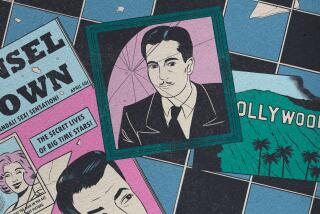GLAAD applauds ‘evolution’ of gay characters on TV
- Share via
Of the 674 leading or supporting actors on prime-time broadcast sitcoms and dramas, 11 are gay characters, according to statistics from the Gay and Lesbian Alliance Against Defamation (GLAAD).
That number is slightly down from two years ago, but the longer-range view proves that there has been a slow and steady rise in the number of gay characters on both network and cable TV.
Scott Seomin, GLAAD’s entertainment media director, said the portrayals are “overwhelmingly good because they’re popular.”
That popularity is one reason gay characters draw attention, even though there are fewer now than in recent years.
Most TV viewers have heard of Bravo’s “Queer Eye for the Straight Guy”; and NBC’s “Will & Grace,” featuring two gay characters, is one of the highest-rated shows of recent seasons.
Although the majority of shows on broadcast television featuring a gay character are sitcoms and often present “stereotypical” portrayals, Seomin said exposure is necessary.
“There are millions of people in this country that do not know” an openly gay person. “Once a week they let Will Truman and Jack McFarland [gay characters played by Eric McCormack and Sean Hayes on “Will & Grace”] into their homes, and they become the gays or lesbians that they know.”
Historically, minorities have been very conscious of what stereotypes were reinforced on television. Seomin said the character of Jack on “Will & Grace” is a stereotype. However, he said, that’s not necessarily a bad thing.
“There has been an evolution. The gay characters have gone from being laughed at to doing all the laughing,” he said.
On the reality-style makeover show “Queer Eye for the Straight Guy,” it is the Fab Five who poke fun at and then offer help to heterosexuals. In addition to makeovers, the group redesigns a “straight guy’s” home and gives a cooking lesson.
However, the stars of “Queer Eye” are not acting. They are actual gay men, not characters.
“Carson [Kressley, of the Fab Five] is a real guy. This is who he is. He is not acting for the cameras. I wouldn’t want him to be anything but Carson, which happens to be fabulously flamboyant. Stereotypes are based in truth and humor,” said Seomin, who noted the more realistic gay characters are found on cable.
“Cable has the best gay representation,” said Seomin, who suggested cable offers depictions that viewers do not see on broadcast TV.
“Broadcast networks have a lot to learn about well-rounded gay” characters, said Seomin, who mentioned HBO’s “The Wire” and “Six Feet Under” as shows with gay characters who are as well-developed and complex as their heterosexual counterparts.
The gay characters on broadcast television usually fit into the same pattern: white, male, celibate and affluent, according to Seomin, who said GLAAD works with networks to stress diversity.
John Sonego, GLAAD’s communication director, said, “The challenge is that it’s not a complete picture. It would be like saying if I’m watching the Miss America pageant, that tells me all I need to know about American women. I should never make an assumption that that tells me everything that would be important for me to understand women in this country. We’re as diverse as everyone else.”
Although the majority of gay roles belong to heterosexual or closeted actors, Seomin said GLAAD would not want it any other way.
“It’s about acting. Gay roles don’t have to go to gay actors. If we were saying that, it would say that [gay actors] can’t play straight roles,” said Seomin, who noted that other minority-character roles are usually offered to members of that minority first.
For instance, an African American actor would be cast to portray Martin Luther King Jr., or if a character has a physical disability, “producers and writers want to give first crack to an actor with that physical disability,” he said.
“That does not hold true for gay or lesbian actors,” Seomin said, “because you can’t tell just by looking. It’s a minority based on sexuality.”
It’s the possibility of graphic sexuality that has groups such as the Parents TV Council watching. But the organization is not just focused on the behavior of gay characters.
“We have expressed concerns about ‘Will & Grace,’ ” said Melissa Caldwell, the council’s director of research and publication. However, she noted, “it’s as much for Grace’s promiscuity than for anything else.”
More to Read
The complete guide to home viewing
Get Screen Gab for everything about the TV shows and streaming movies everyone’s talking about.
You may occasionally receive promotional content from the Los Angeles Times.






